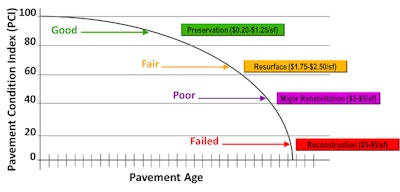
Pavement reports based upon the MICROpaver or PCI (pavement condition index) system have been around for years. These reports are widely used in large municipalities and federal organizations; however, they have not been fully adopted by the commercial and residential world.
This problem is the result of the high upfront costs the reports may require as well as a lack of education on the cost savings in pavement management and preservation. With the cost of new pavement skyrocketing, now more than ever financially conscious property managers are adopting a pavement management plan in order to extend the life of their investments.
1. Save Money on Costly Asphalt Repairs
On average the cost to replace or rehabilitate an asphalt surface runs $3-$5 dollars a square foot for basic removal and replacement. However, the costs can run much higher if subbase work is necessary.
By implementing a pavement maintenance guide, property owners and managers can rest assured that they are doing the most for their asphalt investment. It's easy to see that spending a few cents a square foot on preventative maintenance can save property managers and owners a huge amount of money down the road.
Initiating preventative maintenance can help keep the asphalt surface in the upper limits of the PCI scale. This keeps maintenance costs low and will greatly extend the life of the asphalt pavement.
2. Learn more about their asphalt investment
Property managers paid an arm and a leg for their pavement, but in most cases the asphalt contractor don’t provide information on how to keep it looking and performing great.
Imagine this situation in the case of buying new wood siding for your home. Of course the contractor or supplier would give you a detailed report on how to keep that siding looking new and protected from the elements.
Just like a homeowner should be able to learn about how best to maintain his siding, property managers should be able to understand their pavement investment. They should know what condition it is in currently, where it may be in the next few years and what can be done to protect it for the long haul.
There is a reason that these pavement planning techniques are so widely used in budget-restricted cities throughout the United States: following a pavement maintenance program works! Property managers will see cost savings in the long run and pavement surfaces will look clean and new in the short term. The cost of reconstructing a street can exceed ten times the cost of performing a preventative maintenance treatment.
3. Create a budget for repairs and maintenance
Creating an overall budget for the asphalt investment is possibly one of the most important outcomes a pavement report can have. These reports lay out when and what needs to be done in order to maintain an asphalt surface. By laying out the true numbers years in advance, property managers can budget the appropriate funds to be used.
This information is also helpful when presenting to homeowners association boards. Putting a number and a time frame on a pavement project is always a little easier to swallow than trying to rush a project through without fully investigating all the options.
The main point of a pavement report is to transfer knowledge from a professional contractor to a property manager on what the status of their asphalt is and how they can best manage it.
Luke Surma is project engineer at Yellowstone Pavement Solutions, 5150 Thorpe Road, Belgrade, MT; www.YellowstonePavementSolutions.com.










![Lee Boy Facility 2025 17 Use[16]](https://img.forconstructionpros.com/mindful/acbm/workspaces/default/uploads/2025/09/leeboy-facility-2025-17-use16.AbONDzEzbV.jpg?ar=16%3A9&auto=format%2Ccompress&fit=crop&h=135&q=70&w=240)








